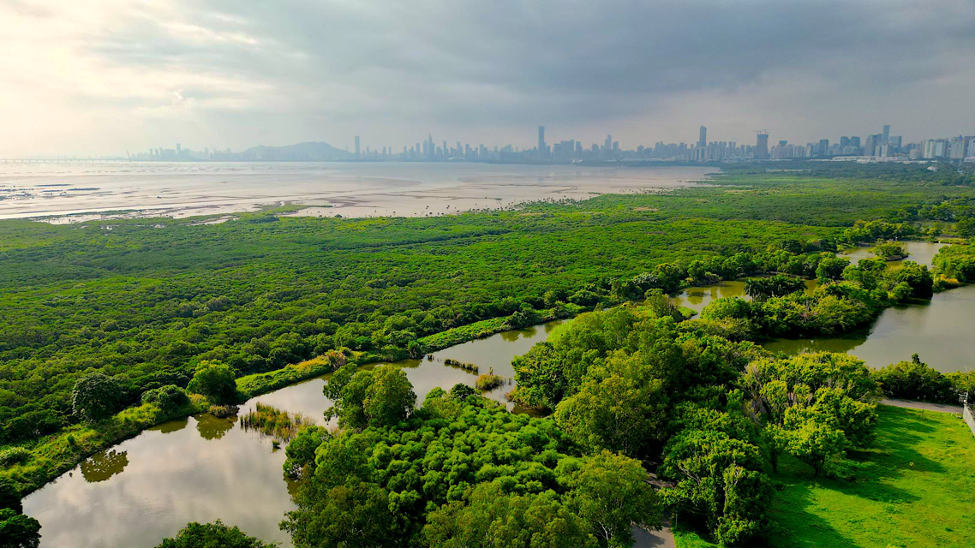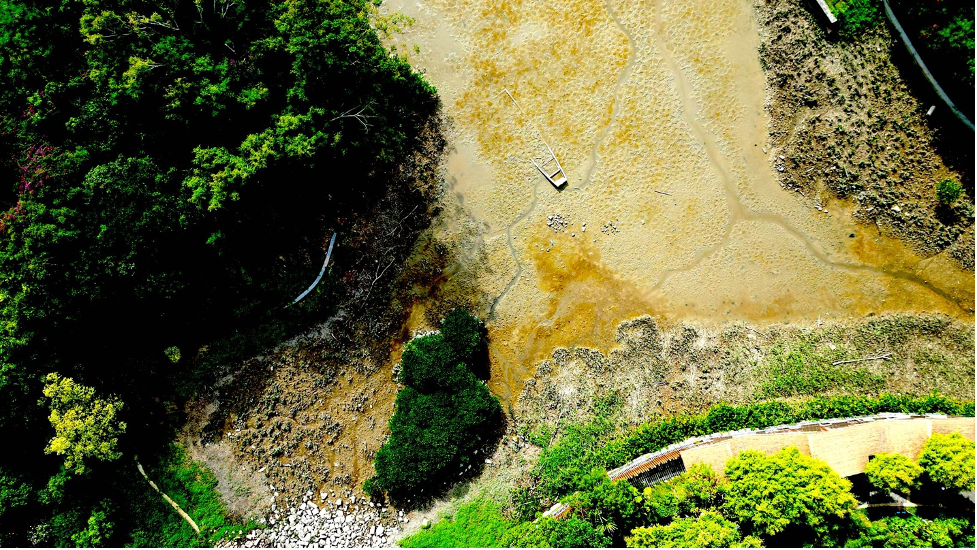Blue carbon ecosystems: powerful yet fragile
Writer: Matteo Convertino | Editor: Liu Minxia | From: | Updated: 2023-11-02
Walking along the coastline is a favorite pastime for many in this city — the fragrance of the sea, the sunrise and sunset and the breeze are a few of the infinite things to enjoy. But something unnerving is happening; where are our coasts going?
沿着海岸线散步是许多人喜欢的消遣方式:大海的芬芳、日出日落和微风都令人着迷。但是美好之下有一些问题不断凸显,我们的海岸线将何去何从呢?
The bad news for humankind is that both oceans and coasts are under pressure, amid atmospheric and marine warming, habitat destruction, pollution, and the impacts of overfishing and industrial activity. These destructive factors are undermining the roles that marine and riverine ecosystems play in slowing down climate change.
在大气和海洋持续变暖、物种栖息地破坏、污染以及过度捕捞和工业活动的影响下,海洋和海岸都受到影响。这些破坏性的因素正在削减海洋和河流生态系统在减缓气候变化方面的作用。
Tangible sea level rise in Shenzen Bay, close to Shenzhen Talent Park. Photos by Matteo Convertino
深圳湾水域海平面上升。
With a projected sea level rise of 0.5-2.0 meters by 2100 driven by a 4°C rise in temperatures, there is the risk of forced displacement of up to 200 million people (3% of the global population) across the globe. The Guangdong-Hong Kong-Macao Greater Bay Area (GBA), home to 80 million, is one of the most vulnerable regions on the planet.
预计到2100年,由于气温上升4摄氏度,海平面将上升0.5到2.0米。这有可能导致全球多达2亿人(占全球人口的3%)被迫离开自己的家园。而拥有8000万人口的粤港澳大湾区,是地球上最脆弱的地区之一。
The bleak prospects are exacerbated by the subsidence of reclaimed land and destroyed coastal ecosystems.
填海造地的沉降和海岸生态系统的破坏使得前景更加暗淡。
Certain coastal ecosystems are called “blue carbon ecosystems.” Tidal marshes, mangroves and seagrass meadows act as deep carbon reservoirs and sequester greenhouse gases with the highest efficiency among all types of ecosystems.
沿海生态系统被称为“蓝碳生态系统”。潮汐沼泽、红树林和海草草甸作为深层碳库,在所有类型的生态系统中封存温室气体的效率最高。
Is there a way to rewind the already tickling clock of ecological decay? I believe the answer is positive, but it must be done with precision and requires a close collaboration of the academia, governments and industries.
是否有办法让已经嘀嗒作响的生态衰败时钟倒退?我相信答案是肯定的,但必须精准地行动,同时也需要学术界、政府和产业界的密切合作。

An aerial view of Futian Mangrove Nature Reserve. Futian Mangrove Nature Reserve is a perfect example of a healthy blue carbon ecosystem.
福田红树林自然保护区的鸟瞰图。福田红树林自然保护区是一个健康的蓝碳生态系统的完美典范。
Futian Mangrove Reserve is a perfect example of a healthy blue carbon ecosystem, where tidal flats and mangroves are supplied with freshwater inflow from the Shenzhen River and other canals — an essential condition for the optimal function and survival of these ecosystems.
福田红树林保护区是一个健康的蓝碳生态系统的完美典范,这里的滩涂和红树林有来自深圳河和其他河流的淡水流入——这是蓝碳生态系统生存和实现最佳功能的必要条件。
An interesting thing noted in the local coastal ecosystems is an increase in carbon sequestration despite the decreasing coverage of vegetation, which can partly be explained by overstimulation of plants in relation to night-time illumination, higher air temperatures and density of carbon dioxide in the atmosphere. Yet it remains to be seen for how long this trend is durable and whether we are creating a “carbon time bomb” that would someday release all the sequestered carbon, in case mangroves disappear due to sea level rise or other factors.
在本地沿海生态系统中,有一个有趣的现象,即尽管植被覆盖率下降,但碳封存量却增加了。这与夜间照明、较高的大气温度和大气二氧化碳浓度增加有关。然而,这种趋势能持续多久还有待观察,我们是否正在制造一个“碳定时炸弹”,如果红树林因海平面上升或其他因素而消失,那么有一天所有封存的碳可能会被释放出来。

An aerial view of Futian Mangrove Ecological Park in Shenzhen where a tidal flat is created in the dry season of a freshwater canal connecting Futian and the mangroves in Shenzhen Bay. The proper hydrologic flow of canals like this one is essential for the optimal function and survivability of mangroves (metaphorically defined as the "rivers of carbon" due to their active role in transferring carbon laterally to the bottom of the ocean).
深圳福田红树林生态公园的鸟瞰图。在旱季,连接福田和深圳湾红树林的淡水运河形成了一个潮汐平地。运河的适当水文流动,对红树林的最佳功能和生存能力至关重要(由于红树林在将碳横向转移到海洋底部发挥了积极的作用,因此被比喻为 "碳的河流")。
Research by the TREES Lab at Tsinghua University, Shenzhen International Graduate School estimates that a tipping point will arrive in 2070, when GBA cities will be threatened by inundation due to sea level rise, if we do nothing about climate change.
清华大学深圳国际研究生院未来生态系统实验室(TREES)的研究估计,如果我们不采取任何措施来应对气候变化,到2070年将出现一个转折点,届时粤港澳大湾区的城市将面临海平面上升带来的威胁。
Some years from now, we may have to adapt to the rising sea level and live in floating houses, alongside other species next to the mangroves.
若干年后,由于海平面上升,我们可能会被迫适应环境的变化,生活在漂浮的房子里,与红树林周边的物种相依为伴。
One solution is tapping into the potential of blue carbon ecosystems by expanding mangrove forests and related habitats that are already in a suboptimal condition.
一个解决方案是通过扩大已经处于次优状态的红树林和相关栖息地来挖掘蓝碳生态系统的潜力。
The healthy functioning of such an ecosystem depends on the equilibrium between species, proper water quantity and quality, and other environmental factors. Here are some aspects we can work on.
生态系统的健康运作取决于物种之间的平衡,适当的水环境以及其他环境因素。以下是我们可以努力的一些方面:
Potential solutions are about the restoration and expansion of lost mangrove habitats (top plot) or de-novo mangrove habitats as future human habitats with floating housing that adjust to sea level rise (bottom plot).
潜在的解决方案是恢复和扩大失去的红树林栖息地(上图),或将红树林栖息地作为未来的人类栖息地,用浮动住房来适应海平面上升(下图)。
First, we can reconnect mangroves with other habitats via drainage networks to ensure they have the necessary freshwater inflow.
首先,我们可以通过排水网络将红树林与其他生境重新连接起来,确保它们有必需的淡水流动。
Second, keystone species for blue carbon habitats such as fish and crustaceans must be preserved for biodiversity balance and ecological functions. For example, crabs provide necessary aeration to mangroves roots, which facilitates carbon sequestration.
第二,为了保持生物多样性和生态功能平衡,必须保护蓝碳生态系统的关键物种,如鱼类和甲壳类动物。例如,螃蟹为红树林的根部提供必要的通气,这有利于碳的固定。
Third, the maximum load of nutrients must be identified and strictly followed for the healthy function of blue carbon vegetation.
第三,为了蓝碳植被的健康功能,必须确定并严格遵守营养物质的最大负荷。
Fourth, we need to keep a close watch on ecosystems for any warning signs.
第四,我们需要密切关注生态系统的任何警示信号。
Finally, everyone has a share in this cause and needs to bear in their mind that acting responsibly benefits not just nature but also humankind.
最后,需要谨记的是每个人都在蓝碳生态系统的保护事业中占有一席之地,负责任的行动不仅有利于自然,也有利于人类。
With these steps, we can leverage climate risks as opportunities to expand blue carbon habitats for the carbon neutrality goal and climate regulation.
通过以上这些步骤,我们可以将气候风险转化为扩大蓝碳栖息地的机会,从而实现碳中和和气候调节的目标。